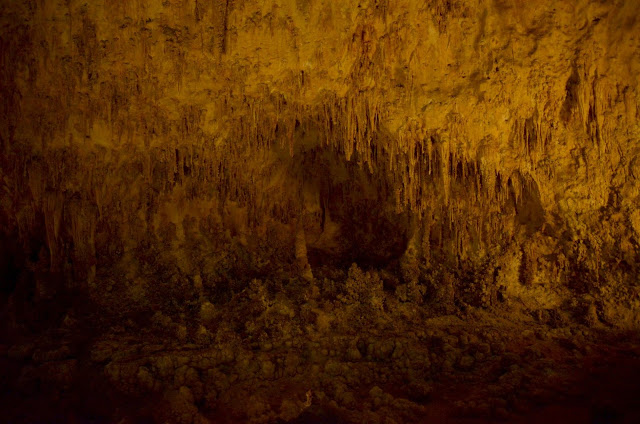Seb by the "Sword of Damocles"--a sharp stalactite nearly touching the stalagmite below
One really interesting thing we learned about Carlsbad Caverns concerned its formation. Most limestone caves are formed when water seeps through cracks in the earth and combines with carbon dioxide to form a watery carbonic acid. This solution eats away at limestone, dissolving the rock and suspending its minerals in the acid. As the water/acid then drains from the cavities it has formed, it begins to drip through other cracks, and each time it drips, some carbon dioxide escapes (it fizzes out like it does when you open a soda can), thus making the acid weaker and less able to hold the minerals dissolved in it. Since the minerals (primarily calcite) are unable to remain in the liquid, they are deposited back into the cave, and these minerals build up over time into speleothems. Most limestone caves, therefore, form in a predictable sequence, with caverns opening up downhill from each other, in the same path running water would follow.
Carlsbad Caverns is different, however, in that its caverns are much much taller and grander than in a typical cave. And the caverns connect to each other in an unpredictable sequence, appearing not to follow the path flowing water would. Also, there are several large deposits of gypsum in the caves, and gypsum isn't a substance that dissolves in carbonic acid, so scientists were puzzled how these deposits got there!
They found the answer in the geology of the area. As we drove down, we saw oil pumps working everywhere! The oil in this area contains hydrogen sulfide, which combines with oxygen (and microbes underground) to make sulfuric acid. And sulfuric acid, unlike carbonic acid, DOES dissolve gypsum. It can also seep upward through the earth, unlike the carbonic acid in water which only flows downward. So many of Carlsbad Caverns' huge chambers were formed from beneath and have no opening to the ground level above! The sulfuric acid is also a much stronger and more aggressive dissolver (is solvent the word I want?) than carbonic acid, and is responsible for the vastness and unpredictable, maze-like arrangement of Carlsbad Caverns. Once some of the higher chambers collapsed and became open to the air and dripping water, then speleothems could begin to form in the caverns through the typical carbonic-acid method. When you think of the combination of special circumstances required to form this cave, you can't help but be amazed that it ever happened at all!
Interesting, eh? :)
Now on to the speleothems!:
A funny group of many stubby stalagmites
Of course, stalactites are everywhere. I can't decide if I like the big dramatic ones,
or the small feathery ones, best!
"Bottle brush"--a stalactite covered with pool spar on the end
I love this huge, dramatic group of stalactites they call "the chandelier." (The surrounding ones are pretty too)
A column, covered with flowstone and small drapery. Flowstone covered almost everything in this cave!
Another view of that column. It's hard to tell how huge it was, but it was 64 feet tall!
More of these complex speleothems. Flowstone, draperies, and pool spar (cave popcorn), all combined!
Beautiful, supple-looking draperies. This looks like a big whale-monster's mouth!
Lovely, smooth flowstone. Some nice shelfstone to the right, also.
Here's some more great shelfstone (this forms along the edges of pools when there is lots of water in the cave, and can give a good picture of where former water levels were)
Lots of pool spar! This forms underwater, like it did in our experiment.
One of my favorites---rimstone dams! These deposits make little walls along the edges of water, and new ones form as the water levels change. I love the stone "ripples" they seem to form.
Rimstone dams (they look like canyon walls here), shelfstone, and pool-spar-covered stalactites and stalagmites!
More beautiful rimstone dams
Shelfstone
Soda straws: baby stalactites!
More baby stalactites. Some are still soda straws, others are just small stalactites.
Some nice draperies (coming from the ceiling above). If this drapery were a bit redder, we could call it "cave bacon." I also love the dramatic flowstone/dripping draperies below. This fat speleothem reminds me of Jabba the Hut!























No comments:
Post a Comment